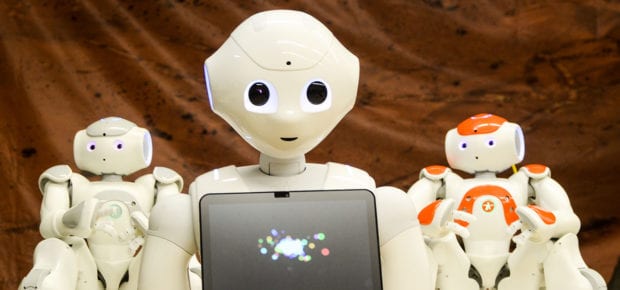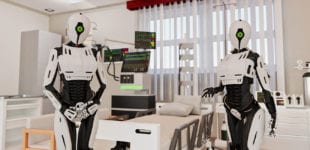November 4, 2019
It’s no surprise that most of us want to keep a level of self-sufficiency and independence as long as possible as we enter old age. IEEE Impact Creator and Senior Member Ayanna Howard is on a mission to improve the quality of life in dementia patients by encouraging daily movement that improves cognitive retention with the help of machine-learning humanoid therapy robots.
“Humanoid therapy allows us to bring in robots that have the same type of form factor as a human therapist, and fill in the gaps from traditional, in-person therapy sessions,” says Howard.
Utilizing this type of robot will help patients who might not be able to afford daily therapeutic care from a human specialist on a regular basis.
“The human might not be available 24 hours a day, seven days a week — but the humanoid robot can be,” says Howard.
The Dancing Humanoid Robot Increases Cognitive Functioning
Howard and her team are currently developing a humanoid robot focused on helping elderly dementia patients retain their short-term memory for longer increments.
“While there is no cure for dementia, recent studies have suggested that exercise may have a positive effect on the cognitive function of dementia patients,” states Howard’s published research study, co-written by Mariah Schrum and Chung Hyuk Park. “We propose that a humanoid therapy robot is an effective tool for encouraging exercise in dementia patients.”
The interactive humanoid robot, nicknamed Pepper, does a sequence of arm movements and upper body dance moves for the patient to follow along. This type of interaction helps a patient physically and mentally exercise with the goal of improving his or her short-term memory.
“If you can maintain short-term memory and improve it, that means you have a higher possibility of being independent,” states Howard.
Howard believes this type of robot will be best utilized in an assisted living home so more patients will have access to care and reduce facility costs because of a reduced need for human therapy interaction.
See also Humanoid Robots Teach Coping Skills to Children With Autism
The Machine-Learning Technologies Used for Humanoid Therapy
“Humanoid robots not only have to understand our emotional state, but also emote in a responsive way,” says Howard. “It is shown that when we have a robot that is socially interactive in an appropriate way, it increases the amount of time a person interacts with that program.”
Pepper uses machine learning technologies and advanced applications to socially adapt and interact with its patients, which aid in increasing the likelihood of improved cognitive functioning.
As a result, “a robot has to identify what their strengths are and where they need improvement,” says Howard. “As the patient improves, the robot should adapt as well.”
These adaptations are made from actual human observation and then the engineers code those insights into the humanoid robot.
“There are studies that show there is a learning curve for most things,” says Howard. “If we can figure out where you are on the learning curve, we can predict how you’re supposed to learn. If you do something and it doesn’t predict where you should be, then the robot has to adapt what it is doing.”
Facial recognition is another way Pepper is able to assess and interact with a human successfully. Yet, Howard has found in her research that facial recognition does not work as well on children and older adults because there is less data on these demographics. She and her team are currently working on programming the APIs to fit their needs.
“It’s collecting images, codifying it, and then training a typical neural network on that,” says Howard. “It’s a hybrid, so we use the APIs that are already out there. Then that data is imported into our own algorithms that have done more specialized learning on that targeted demographic.”
Howard hopes to publish an article further outlining this research on elder facial recognition by the end of the year. Pepper is still currently in the research stage, and Howard predicts the work will not be done until next year.
Howard’s work in humanoid therapy robotics looks promising for older adults who suffer from dementia. By dancing with Pepper, Howard and her team hopes to see an increase of cognitive retention and independence in patients living in assisted living homes as a result.






 The Impact of Technology in 2025
The Impact of Technology in 2025 Quantum and AI: Safeguards or Threats to Cybersecurity?
Quantum and AI: Safeguards or Threats to Cybersecurity? Why AI Can't Live Without Us
Why AI Can't Live Without Us Bits, Bytes, Buildings and Bridges: Digital-Driven Infrastructure
Bits, Bytes, Buildings and Bridges: Digital-Driven Infrastructure Impact of Technology in 2024
Impact of Technology in 2024 Emerging AI Cybersecurity Challenges and Solutions
Emerging AI Cybersecurity Challenges and Solutions The Skies are Unlimited
The Skies are Unlimited Smart Cities 2030: How Tech is Reshaping Urbanscapes
Smart Cities 2030: How Tech is Reshaping Urbanscapes Impact of Technology 2023
Impact of Technology 2023 Cybersecurity for Life-Changing Innovations
Cybersecurity for Life-Changing Innovations Smarter Wearables Healthier Life
Smarter Wearables Healthier Life Infrastructure In Motion
Infrastructure In Motion The Impact of Tech in 2022 and Beyond
The Impact of Tech in 2022 and Beyond Cybersecurity, Technology and Protecting Our World
Cybersecurity, Technology and Protecting Our World How Technology Helps us Understand Our Health and Wellness
How Technology Helps us Understand Our Health and Wellness The Resilience of Humanity
The Resilience of Humanity Harnessing and Sustaining our Natural Resources
Harnessing and Sustaining our Natural Resources Creating Healthy Spaces Through Technology
Creating Healthy Spaces Through Technology Exceptional Infrastructure Challenges, Technology and Humanity
Exceptional Infrastructure Challenges, Technology and Humanity The Global Impact of IEEE's 802 Standards
The Global Impact of IEEE's 802 Standards Scenes of our Cyber Lives: The Security Threats and Technology Solutions Protecting Us
Scenes of our Cyber Lives: The Security Threats and Technology Solutions Protecting Us How Millennial Parents are Embracing Health and Wellness Technologies for Their Generation Alpha Kids
How Millennial Parents are Embracing Health and Wellness Technologies for Their Generation Alpha Kids Space Exploration, Technology and Our Lives
Space Exploration, Technology and Our Lives Global Innovation and the Environment
Global Innovation and the Environment How Technology, Privacy and Security are Changing Each Other (And Us)
How Technology, Privacy and Security are Changing Each Other (And Us) Find us in booth 31506, LVCC South Hall 3 and experience the Technology Moon Walk
Find us in booth 31506, LVCC South Hall 3 and experience the Technology Moon Walk Virtual and Mixed Reality
Virtual and Mixed Reality How Robots are Improving our Health
How Robots are Improving our Health IEEE Experts and the Robots They are Teaching
IEEE Experts and the Robots They are Teaching See how millennial parents around the world see AI impacting the lives of their tech-infused offspring
See how millennial parents around the world see AI impacting the lives of their tech-infused offspring Take the journey from farm to table and learn how IoT will help us reach the rising demand for food production
Take the journey from farm to table and learn how IoT will help us reach the rising demand for food production Watch technical experts discuss the latest cyber threats
Watch technical experts discuss the latest cyber threats Explore how researchers, teachers, explorers, healthcare and medical professionals use immersive technologies
Explore how researchers, teachers, explorers, healthcare and medical professionals use immersive technologies Follow the timeline to see how Generation AI will be impacted by technology
Follow the timeline to see how Generation AI will be impacted by technology Learn how your IoT data can be used by experiencing a day in a connected life
Learn how your IoT data can be used by experiencing a day in a connected life Listen to technical experts discuss the biggest security threats today
Listen to technical experts discuss the biggest security threats today See how tech has influenced and evolved with the Games
See how tech has influenced and evolved with the Games Enter our virtual home to explore the IoT (Internet of Things) technologies
Enter our virtual home to explore the IoT (Internet of Things) technologies Explore an interactive map showcasing exciting innovations in robotics
Explore an interactive map showcasing exciting innovations in robotics Interactively explore A.I. in recent Hollywood movies
Interactively explore A.I. in recent Hollywood movies Get immersed in technologies that will improve patients' lives
Get immersed in technologies that will improve patients' lives